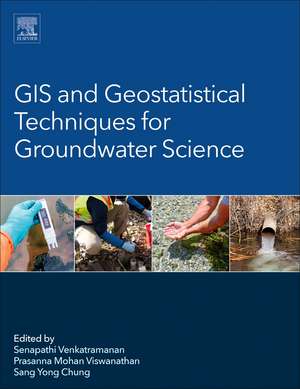GIS and Geostatistical Techniques for Groundwater Science
Editat de Senapathi Venkatramanan, Prasanna Mohan Viswanathan, Sang Yong Chungen Limba Engleză Paperback – 29 mai 2019
- Provides details on the application of GIS and statistics in groundwater studies
- Includes practical coverage of the use of spatial analysis techniques in groundwater science
- Bridges the gap between geostatistics and GIS as it relates to groundwater science and management
- Offers worldwide case studies to illustrate various techniques and applications in addressing groundwater issues
Preț: 638.58 lei
Preț vechi: 830.04 lei
-23% Nou
Puncte Express: 958
Preț estimativ în valută:
122.19€ • 127.33$ • 101.17£
122.19€ • 127.33$ • 101.17£
Carte tipărită la comandă
Livrare economică 27 martie-10 aprilie
Preluare comenzi: 021 569.72.76
Specificații
ISBN-13: 9780128154137
ISBN-10: 0128154136
Pagini: 389
Dimensiuni: 216 x 276 x 24 mm
Greutate: 0.9 kg
Editura: ELSEVIER SCIENCE
ISBN-10: 0128154136
Pagini: 389
Dimensiuni: 216 x 276 x 24 mm
Greutate: 0.9 kg
Editura: ELSEVIER SCIENCE
Public țintă
Geologists, Geophysicists, Geochemists, Environmentalists, Hydrogeologists, Soil scientists, environmental engineersCuprins
Introduction and History of GIS and Geostatistical Techniques in Groundwater Science
1. Fundamentals of GIS
2. General Introduction of Geostatistical Techniques
3. History of GIS and Geostatistical techniques in groundwater science
4. Merits and Demerits of GIS and Geostatistical Techniques
Types of Geospatial Analysis Techniques
5. Introduction of various spatial analyses
6. Inverse distance weighted and Kriging
7. Spline
8. Fuzzy
9. Cluster and Grouping Analysis
10. Correlation and Regression
11. Time Series Analysis
12. Artificial Neural Network
Groundwater quality assessment using GIS and Geostatistical aspects
13. Groundwater contaminations related with climate change
14. Groundwater quality contamination related with urbanization
15. Groundwater and Surface Water Interaction
16. Groundwater Contamination Related to Seawater Intrusion
17. Organic Contamination (Hydrocarbon, LNAPL, DNAPL)
18. Fluoride contamination
19. Arsenic contamination
20. Heavy metal contamination
Application of GIS and Geostatistical techniques in groundwater resources management
21. Groundwater, River basin, Watershed management
22. Water management for agricultural utilization
1. Fundamentals of GIS
2. General Introduction of Geostatistical Techniques
3. History of GIS and Geostatistical techniques in groundwater science
4. Merits and Demerits of GIS and Geostatistical Techniques
Types of Geospatial Analysis Techniques
5. Introduction of various spatial analyses
6. Inverse distance weighted and Kriging
7. Spline
8. Fuzzy
9. Cluster and Grouping Analysis
10. Correlation and Regression
11. Time Series Analysis
12. Artificial Neural Network
Groundwater quality assessment using GIS and Geostatistical aspects
13. Groundwater contaminations related with climate change
14. Groundwater quality contamination related with urbanization
15. Groundwater and Surface Water Interaction
16. Groundwater Contamination Related to Seawater Intrusion
17. Organic Contamination (Hydrocarbon, LNAPL, DNAPL)
18. Fluoride contamination
19. Arsenic contamination
20. Heavy metal contamination
Application of GIS and Geostatistical techniques in groundwater resources management
21. Groundwater, River basin, Watershed management
22. Water management for agricultural utilization
